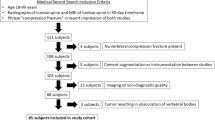Abstract
Purpose
How the lumbar neural foramina are affected by segmental deformities in patients in whom degenerative lumbar scoliosis (DLS) is unknown. Here, we used multidetector-row computed tomography (MDCT) to measure the morphology of the foramina in three dimensions, which allowed us to elucidate the relationships between foraminal morphology and segmental deformities in DLS.
Methods
In 77 DLS patients (mean age, 69.4) and 19 controls (mean age, 69), the foraminal height (FH), foraminal width (FW), posterior disc height (PDH), interval between the pedicle and superior articular process (P-SAP), and cross-sectional foraminal area (FA) were measured on reconstructed MDCT data, using image-editing software, at the entrance, minimum-area point, and exit of each foramen. The parameters of segmental deformity included the intervertebral wedging angle and anteroposterior and lateral translation rate, measured on radiographs, and the vertebral rotation angle, measured using reconstructed MDCT images.
Results
The FH, PDH, P-SAP, and FA were smaller at lower lumbar levels and on the concave side of intervertebral wedging (p < 0.05). In the DLS patients, the FH, P-SAP, and FA were significantly smaller than for the control group at all three foraminal locations and every lumbar level (p < 0.05). Intervertebral wedging strongly decreased the FA of the concave side (p < 0.05). Anteroposterior translation caused the greatest reduction in P-SAP (p < 0.05). Vertebral rotation decreased the P-SAP and FA at the minimum-area point on the same side as the rotation (p < 0.05).
Conclusion
The new analysis method proposed here is useful for understanding the pathomechanisms of foraminal stenosis in DLS patients.




Similar content being viewed by others
References
Saint-Louis LA (2001) Lumbar spinal stenosis assessment with computed tomography, magnetic resonance imaging, and myelography. Clin Orthop 384:122–136
Burton R, Kirkaldy-Willis W, Yong-Hing K et al (1981) Cases of failure of surgery on the lumbar spine. Clin Orthop 157:191–197
MacNab I (1971) Negative disc exploration: an analysis of the causes of nerve root involvement in sixty-eight patients. J Bone Joint Surg Am 53:891–903
Schlegel JD, Champine J, Taylor MS et al (1994) The role of distraction in improving the space available in the lumbar stenotic canal and foramen. Spine 18:2041–2047
Inufusa A, An HS, Lim TH et al (1996) Anatomic changes of the spinal canal and intervertebral foramen associated with flexion-extension movement. Spine 21:2412–2420
Stephens MM, Evans JH (1991) Lumbar intervertebral foramens: an in vitro study of their shape in relation to intervertebral disc pathology. Spine 16:525–529
Ploumis A, Transfeldt EE, Gilbert TJ et al (2006) Degenerative lumbar scoliosis: radiographic correlation of lateral rotatory olisthesis with neural canal dimensions. Spine 31:2353–2358
Fujiwara A, An HS, Lim TH et al (2001) Morphologic changes in the lumbar intervertebral foramen due to flexion-extension, lateral bending, and axial rotation: an in vitro anatomic and biomechanical study. Spine 26:876–882
Kunogi J, Hasue M (1991) Diagnosis and operative treatment of intraforaminal and extraforaminal nerve root compression. Spine 16:1312–1320
Jenis LG, An HS (2000) Spine update: lumbar foraminal stenosis. Spine 25:389–394
Conflict of interest
None.
Author information
Authors and Affiliations
Corresponding author
Rights and permissions
About this article
Cite this article
Kaneko, Y., Matsumoto, M., Takaishi, H. et al. Morphometric analysis of the lumbar intervertebral foramen in patients with degenerative lumbar scoliosis by multidetector-row computed tomography. Eur Spine J 21, 2594–2602 (2012). https://doi.org/10.1007/s00586-012-2408-7
Received:
Revised:
Accepted:
Published:
Issue Date:
DOI: https://doi.org/10.1007/s00586-012-2408-7




